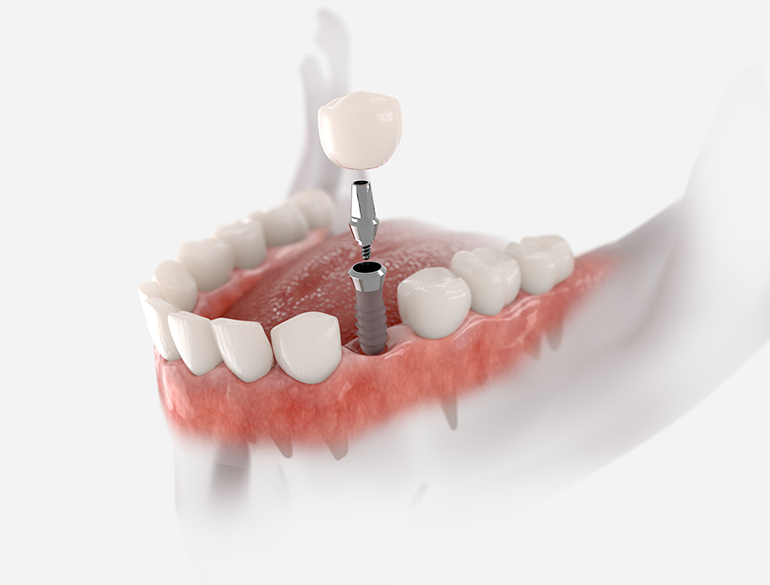The Dental Sense PDFs
The Dental Sense PDFs
Blog Article
The Only Guide for Dental Sense
Table of ContentsThe Definitive Guide to Dental SenseThe Ultimate Guide To Dental SenseThe Ultimate Guide To Dental SenseDental Sense for Beginners
are clinical devices operatively dental implanted right into the jaw to restore a person's capability to eat or their appearance. They give support for artificial (fake) teeth, such as crowns, bridges, or dentures. When a tooth is lost due to injury or condition, a person can experience problems such as quick bone loss, faulty speech, or changes to eating patterns that lead to pain.Oral implant systems contain an oral implant body and oral implant abutment and might additionally consist of an abutment addiction screw. Front tooth filling. The oral implant body is surgically put in the jawbone instead of the tooth's origin. The dental implant abutment is usually connected to the implant body by the joint addiction screw and extends through gum tissues right into the mouth to support the connected artificial teeth
(https://dentalsense.godaddysites.com/f/transform-your-smile)Structure of The Dental Implant System picking dental implants, speak with your oral provider concerning the prospective benefits and dangers, and whether you are a candidate for the treatment. Points to consider: Your overall health and wellness is a vital factor in establishing whether you are a good candidate for dental implants, how much time it will certainly take to recover, and the length of time the dental implant might remain in area.
Cigarette smoking may affect the recovery procedure and lower the long-lasting success of the implant. The healing process for the implant body may take numerous months or longer, during which time you commonly have a short-lived joint in area of the tooth. the oral implant treatment: Meticulously follow the oral health directions given to you by your dental copyright.
The Ultimate Guide To Dental Sense
Implant failure can lead to the need for one more surgery to repair or replace the dental implant system. Recovers the capacity to eat Recovers cosmetic appearance Assists keep the jawbone from diminishing as a result of bone loss Protects the wellness of the surrounding bone and gums Assists keep nearby (neighboring) teeth steady Improves high quality of life Damages to surrounding natural teeth during dental implant positioning Injury to the surrounding tissues during surgical procedure, such as sinus opening Injury during surgical procedure (for instance, crack of surrounding jawbone) Inadequate feature, such as seeming like the teeth do not attack together normally An experience that the tooth hangs or twisting in position resulting from a joint screw loosening up Implant body failure (looseness of the dental implant body) due to systemic infection, which might be most likely in people with uncontrolled diabetics issues because of local infection in bone and gums sustaining the implant body because of delayed healing, which may be more probable in individuals who smoke Difficulty cleaning the gum tissues around the implant, resulting in inadequate dental health Untreated periodontal illness Post-surgical numbness because of nerve impingement or damage Constantly alert health treatment service providers and imaging service technicians that you have dental implants before any type of magnetic vibration imaging (MRI) or x-ray procedures.
FDA is not knowledgeable about any kind of unfavorable occasions reported for MRI or x-ray procedures with oral implants. Oral implants systems are generally constructed from materials that comply with worldwide consensus criteria of the International Company for Standardization (ISO) or ASTM International. These criteria have information of what makes a safe material.

An oral implant is a framework that changes a missing tooth. With screw-like tools, the cosmetic surgeon inserts a dental implant right into the jawbone, and it serves as an anchor for an artificial tooth, called a crown. A device called an abutment links the man-made tooth to the dental implant. The crown is personalized to fit the person's mouth and match the color of their teeth.
Unknown Facts About Dental Sense
Some people are not qualified for oral implant surgical procedure. It is for oral surgeons to operate individuals with: severe illnessuncontrollable metabolic diseasebone or soft tissue condition or infectionIf these issues are fixed, a person can have the surgical treatment. In, oral specialists avoid running on individuals with: If individuals with any of the above undergo oral implant surgical treatment, there is a greater danger of the dental implant falling short.

Dental implant surgical treatment is a personalized process. It's not image source the very same for everybody. The following gives a basic review of what you can anticipate your dental expert, dental cosmetic surgeon, periodontist or prosthodontist to do: Place the dental implant surgically. Provide you time to recover. Attach the post and last crown, bridge or denture.
Next off, your doctor will meticulously put the oral implant right into your jaw. Lastly, your doctor will certainly reposition your periodontals and shut the incision with stitches. If your implant is near the front of your mouth, your dental professional will make a temporary tooth for you to wear till you recover. This way, you won't have a void in your smile while you recuperate.
The Facts About Dental Sense Uncovered
Throughout the healing stage, your jawbone should fuse to the oral implant. This process can take anywhere from 3 to nine months.
As soon as your implant heals, your dental professional can affix the joint (small connector post) and your last remediation (crown, bridge or denture). This usually takes about one hour to complete and may call for a 2nd small surgical procedure. You should not feel any kind of discomfort throughout your dental implant procedure since your copyright will certainly utilize medicine to numb your periodontals.
Report this page